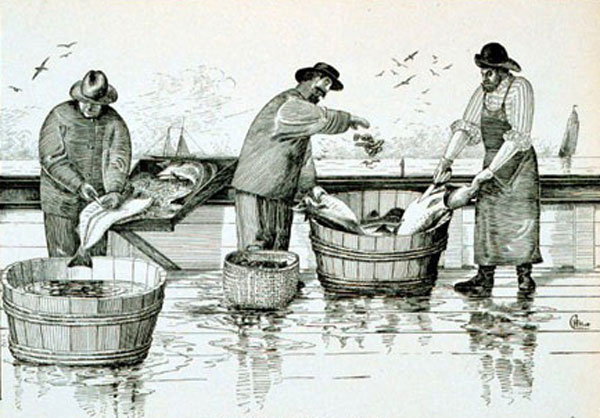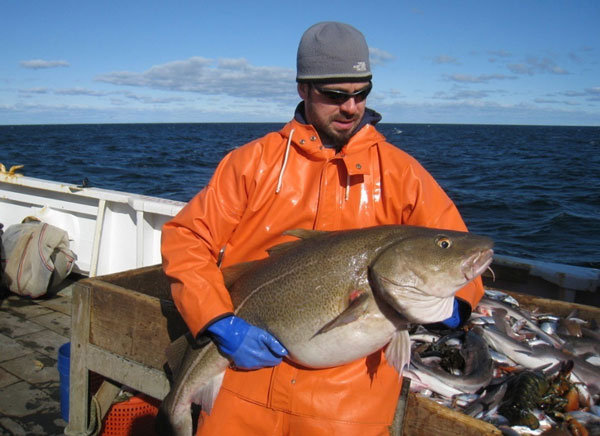Collapse of Cod Fishery Blamed on Inadequate Assessment
by Laurie Schreiber

This vintage drawing depicts fishermen processing cod on the deck of a fishing schooner.
National Oceanic and Atmospheric Administration image
In 2008, fishery scientists judged that the Gulf of Maine cod stock was doing pretty well.
Like many groundfish stocks throughout the Northeast, the Gulf of Maine cod stock had been severely depleted due to overfishing. In the 1990s, federal law drove a new management regime designed to protect groundfish and boost their numbers to sustainable levels. The deadline for rebuilding Gulf of Maine cod was 2014.
According to a stock assessment published in 2008, it appeared that the stock was well on target and could support continued fishing. According to assessment scientist James Weinberg, the assessment indicated that, by 2007, the stock had reached 58 percent of the biomass target. And, Weinberg said, “The indications were that a large recruitment was coming in, which was projected to rebuild the stock, if realized.”
Weinberg is a scientist with the Northeast Fisheries Science Center (NEFSC) in Woods Hole, Mass., and the chairman of the stock assessment process for groundfish. Speaking with the New England Fisheries Management Council (NEFMC) at its January meeting in Portsmouth, N.H., Weinberg said the 2008 assessment turned out to be faulty.
An updated assessment, completed in January, has revealed that the stock continues to be overfished, he said. Even if fishing were immediately to halt, the stock will not be rebuilt by 2014, said Weinberg. With zero fishing, he said, the stock won’t reach a sustainable level until 2018.
Fishery managers are now searching for ways to avoid a complete shutdown of the GOM cod fishery. This stock is considered a “choke” species—when fishing is halted on a choke species, fishermen who harvest other species must also stop fishing if their gear type is capable of catching the choke species.
At the Feb. 10 meeting of the Gulf of Maine Cod Working Group, the National Marine Fisheries Service (NMFS) and NEFMC, with input from the fishing industry and other interested parties, deliberated on the prospect of drastically reducing the catch level for cod, beginning either in the upcoming fishing year that begins on May 1, or for the next fishing year that begins on May 1, 2013.
Michael Ruccio, a fishery policy analyst with NMFS’ Northeast Regional Office in Gloucester, Mass., said that, if NMFS were to end overfishing in 2012, the catch level—also known as the annual catch limit which, in fishery parlance, is simply termed “the ACL”—would have to be reduced to approximately 1,500 mt, an 82.4 percent reduction of fishing from the 2011 catch level of 8,545 mt.
Instead, in order to mitigate the sudden onset of what have been called potentially devastating socio-economic impacts to the fishing industry and fishing communities, NEFMC asked NMFS to consider setting catch levels for fishing year 2012 at 6,700 metric tons— a 21.6-percent reduction from the 2011 catch level.
Sam Rauch, NMFS acting director, said the agency is empowered by federal fishery law, in the form of the Magnuson-Stevens Act, to institute a measure to reduce (but not end) overfishing, on an interim basis for a period limited to one year.
NEFMC also asked for measures that would result in corresponding limits on recreational catches. And NEMFC asked NMFS to consider opening groundfish closed areas to provide fishermen with more fishing opportunities. Ruccio said that NMFS is in the process of evaluating NEFMC’s recommendations.
To date, Ruccio said, NMFS has determined that an ACL higher than 6,700 mt would increase fishing mortality in 2012, whereas an ACL at or below 6,700 mt would reduce fishing mortality and maintain or increase biomass. Ultimately, said Ruccio, the industry still faces “substantial” reductions in the ACL for 2013, in order to end overfishing.
For example, Ruccio said, fishing at 6,700 mt in 2012 would require a 2013 catch level of approximately 2,000 mt. According to Rauch, the GOM cod stock will be considered “recovered” when it reaches a biomass level of 61,218 metric tons. That figure is considered a healthy population for cod, Rauch said.
In an assessment published in 2008, scientists estimated there were 33,877 metric tons of adult cod in the Gulf of Maine in 2007. The stock was still considered overfished, but well on its way to recovery, Rauch said.
But when scientists reassessed the data for an assessment published late in 2011, they revised their estimate of the GOM cod stock to 10,778 metric tons, about 68 percent less cod than they had previously thought, and only 19 percent of the biomass target, said Weinberg.
Part of the problem with the 2008 assessment, said Weinberg, was that the 2005 cod year class in the Gulf of Maine was less strong than suggested by analyses conducted in 2008.

Gulf of Maine cod, called a “lifeline of our inshore fishing fleet up and down the coast of New England” by the Conservation Law Foundation, is in crisis, according to fishery managers. Northeast Fisheries Science Center photo
Weinberg told the NEFMC that tow surveys appeared to show that there was a strong “pulse” of recruitment coming in with the 2005 year-class. But, he said, that conclusion was based on only one or two large tows.
“That jacked up the estimate of the biomass, which had a big influence on the result,” he said. “It’s always under debate, when you catch a boomer tow, what to do with that. It’s not unusual to encounter this sort of thing.”
Weinberg said that assessment scientists—who form a joint group called the Stock Assessment Workshop/Stock Assessment Review Committee, which is abbreviated in fishery parlance to “SAW/SARC”—intend to investigate improvements for incorporating tow survey data into future assessments.
He said the group will also investigate other aspects observed in recent years with this stock. For one, he said, the stock appears to form concentrated aggregations more than it once did. And there is a need to better define what constitutes the Gulf of Maine cod stock, as opposed to cod stocks found elsewhere.
Paul Rago, chief of NEFSC’s Population Dynamics Branch, said that incoming recruitment continues to be low. A survey conducted off Massachusetts in spring 2011 appeared to indicate the stock’s recruitment was among the lowest on record, he said.
“Recruitment” refers to the number of fish that have been spawned in a single year; those fish will grow to become spawning adults. There can be no “recruits” if there are no adult fish to spawn them.
Rago said the current biomass is lower than it has been for the past 19 years and it continues to decrease.
“We’re hearing there’s a collapse and there’s no fish,” said NEFMC member Frank Blount.
NEMFC member David Goethel wanted to know why fishery managers should trust the 2011 assessment, given the errors in the science that went into the 2008 process.
“In the end, the elephant in the room remains, why should it be accepted that the current data and model provide the best available science?” Goethel said.
“In 2008, the spawning stock biomass for 2007 was estimated to be 34,000 metric tons, based on the best available science. In 2011, due solely to a recalculation of the input data used in the 2008 assessment, the 2007 spawning stock biomass was estimated to be some 14,500 metric tons lower. That’s a decrease of about 42 percent. So to me, it’s disturbing to hear that’s the best available science and we’ve basically had a 42 percent error. So why should we believe you now? That’s what everybody in this room wants to ask. Suppose you come back in three years and say, ‘Oh sorry, we were actually off by 80 percent in 2011; the stock is bigger than we thought it was then?’”
Rago said that scientists have greater confidence in the examination of the data used for the 2011 assessment.
“The modeling approach used in this assessment represents a quantum leap, in terms of the ability to handle the underlying data and also its uncertainty,” Rago said. “There was far more rigorous treatment of the discard information and its consequence, and also of the treatment of the landings and the survey data. I realize everyone is in a difficult situation and I appreciate the gravity of the question and the context in which we’re working now. Science is always one of continuous improvement and I hope that this represents an improvement in that science.”
Still, he said, “Is there a possibility that something is catastrophically wrong in the underlying data? Could it occur again? Could something else be revealed? That’s always a possibility. I don’t deny that.”
But, he said, the assessment process for GOM cod and for all other fisheries benefits from continuous improvements to fisheries data. For cod, these include the inclusion of data associated with the recreational fishery and with the relatively new sector management system, as well as a reexamination of the methodologies used to estimate patterns of fish removals, and improvements to monitoring programs.
“There are a huge number of uncertainties that have been raised,” Rago said. “We’re attempting to address them as they arise. I think the one major structural issue—the issue of stock structure and its potential redefinition—that’s one that will take a concerted effort, to redefine the stock and fully understand its implications for management.”
“I think that’s exactly where we need to go before we put everyone in the Gulf of Maine out of business,” said Goethel. “I think we need to have a thorough reexamination of everything here. We need to examine cod, period. We need new reference points, we need new SARC boundaries. We need all this done, and then we can address the underlying problems, if they still exist. I’m not prepared to shut down the Gulf of Maine, or to put out a [limit on catch levels] that would shut down the Gulf of Maine until we address these issues.”
On Feb. 1, Maine’s congressional delegation joined 15 other legislators from around New England to send a letter requesting Secretary of Commerce John Bryson’s help to institute the interim measure.
“New England’s historic Gulf of Maine cod fishery has been subject to an increasingly complex set of management restrictions intended to reduce fishing effort and rebuild the stock to sustainable levels since 1994,” the letter says. “In 2008, when the New England Fishery Management Council met for its September meeting to review the Groundfish Assessment Review Meeting (GARM III) results, the best available science showed that those sacrifices had finally borne fruit: Gulf of Maine cod were declared no longer overfished.
Three years later, an updated assessment painted a dramatically different picture and could not be more ill-timed. Proposed catch levels derived from the 2011 assessment would devastate the commercial fleet with nascent groundfish sectors constrained by the ultimate ‘choke stock.’”
In a subsequent statement, Peter Shelley, Conservation Law Foundation vice president, said he has called on John Bryson, Secretary of the U.S. Department of Commerce, for federal fisheries disaster relief and interim emergency action.
In his letter to Bryson, dated Feb. 21, Shelley wrote, “We are writing to you now to support the earlier requests by [Massachusetts] Governor Deval Patrick for federal fisheries disaster relief… The new scientific assessments for Gulf of Maine cod stocks document that the economic situation in the region is significantly more dire than previously thought. Immediate and aggressive action is needed to avoid any risk of creating a long-lasting biological crisis with GOM cod with widespread, crippling economic implications.”
